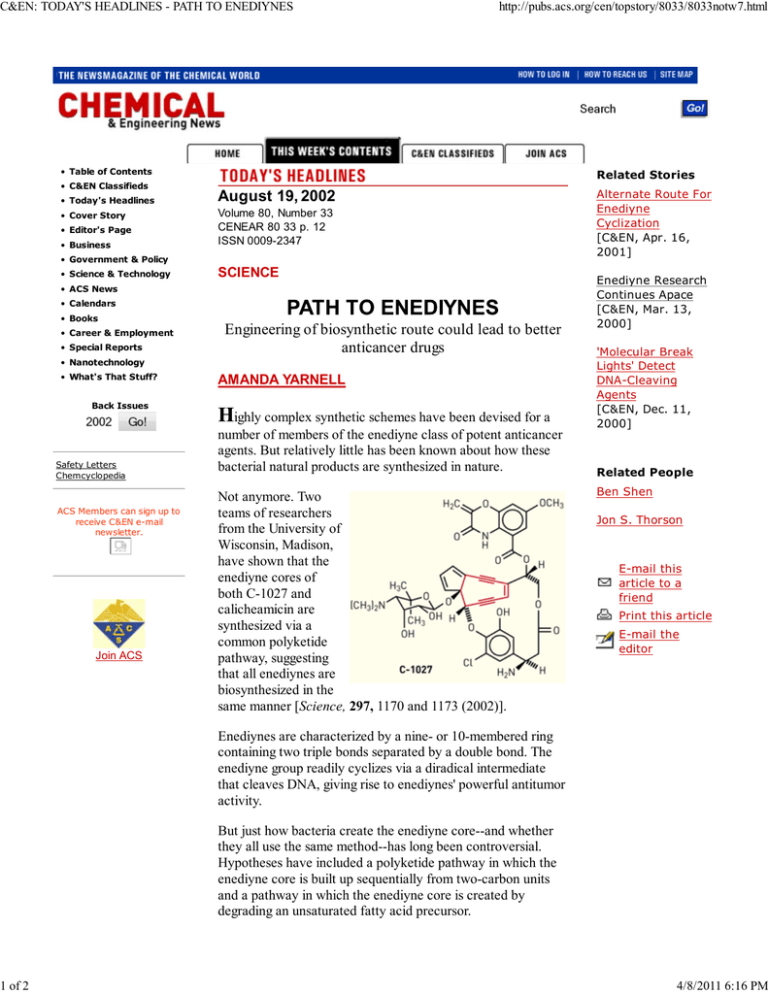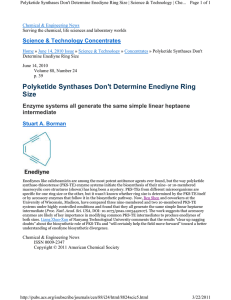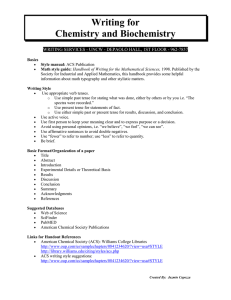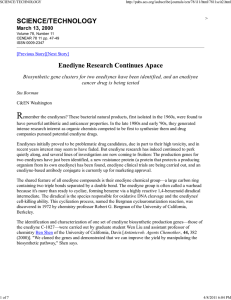
C&EN: TODAY'S HEADLINES - PATH TO ENEDIYNES
http://pubs.acs.org/cen/topstory/8033/8033notw7.html
• Table of Contents
• C&EN Classifieds
• Today's Headlines
• Cover Story
• Editor's Page
• Business
Related Stories
August 19, 2002
Volume 80, Number 33
CENEAR 80 33 p. 12
ISSN 0009-2347
• Government & Policy
• Science & Technology
SCIENCE
• ACS News
• Calendars
• Books
• Career & Employment
• Special Reports
Engineering of biosynthetic route could lead to better
anticancer drugs
• Nanotechnology
• What's That Stuff?
AMANDA YARNELL
Back Issues
Safety Letters
Chemcyclopedia
ACS Members can sign up to
receive C&EN e-mail
newsletter.
Join ACS
ighly complex synthetic schemes have been devised for a
number of members of the enediyne class of potent anticancer
agents. But relatively little has been known about how these
bacterial natural products are synthesized in nature.
Not anymore. Two
teams of researchers
from the University of
Wisconsin, Madison,
have shown that the
enediyne cores of
both C-1027 and
calicheamicin are
synthesized via a
common polyketide
pathway, suggesting
that all enediynes are
biosynthesized in the
same manner [Science, 297, 1170 and 1173 (2002)].
Alternate Route For
Enediyne
Cyclization
[C&EN, Apr. 16,
2001]
Enediyne Research
Continues Apace
[C&EN, Mar. 13,
2000]
'Molecular Break
Lights' Detect
DNA-Cleaving
Agents
[C&EN, Dec. 11,
2000]
Related People
Ben Shen
Jon S. Thorson
E-mail this
article to a
friend
Print this article
E-mail the
editor
Enediynes are characterized by a nine- or 10-membered ring
containing two triple bonds separated by a double bond. The
enediyne group readily cyclizes via a diradical intermediate
that cleaves DNA, giving rise to enediynes' powerful antitumor
activity.
But just how bacteria create the enediyne core--and whether
they all use the same method--has long been controversial.
Hypotheses have included a polyketide pathway in which the
enediyne core is built up sequentially from two-carbon units
and a pathway in which the enediyne core is created by
degrading an unsaturated fatty acid precursor.
1 of 2
4/8/2011 6:16 PM
C&EN: TODAY'S HEADLINES - PATH TO ENEDIYNES
http://pubs.acs.org/cen/topstory/8033/8033notw7.html
Ben Shen, associate professor of pharmaceutical sciences and
chemistry, and coworkers cloned and characterized the stretch
of the Streptomyces globisporus genome necessary for
biosynthesis of the nine-membered enediyne C-1027.
Disruption of the single polyketide synthase (PKS) gene in this
region stops C-1027 production, they find.
Working in Micromonospora echinospora ssp. calichensis,
pharmaceutical sciences associate professor Jon S. Thorson,
Chris M. Farnet of Ecopia Biosciences, and coworkers found
that a homologous PKS gene in the calicheamicin gene cluster
is required for production of this 10-membered enediyne.
In both sequence and organization, the C-1027 and
calicheamicin PKSs are remarkably similar. "Taken together,
our findings suggest that all enediynes share a common
polyketide biosynthetic pathway," Thorson says.
Despite their potency, the enediynes' reactivity and toxicity
have limited their usefulness as drugs. But by disrupting a
hydroxylase gene in the C-1027 cluster, Shen's team created a
novel C-1027 analog with improved chemical stability. "The
work opens the door to genetic manipulation of these
biosynthetic pathways to develop new drug candidates," Shen
says.
Top
Chemical & Engineering News
Copyright © 2002 American Chemical Society
Home | Table of Contents | Today's Headlines | Business | Government & Policy | Science & Technology | C&EN Classifieds
About C&EN | How To Reach Us | How to Advertise | Editorial Calendar | Email Webmaster
Chemical & Engineering News
Copyright © 2002 American Chemical Society. All rights reserved.
• (202) 872-4600 • (800) 227-5558
2 of 2
4/8/2011 6:16 PM








